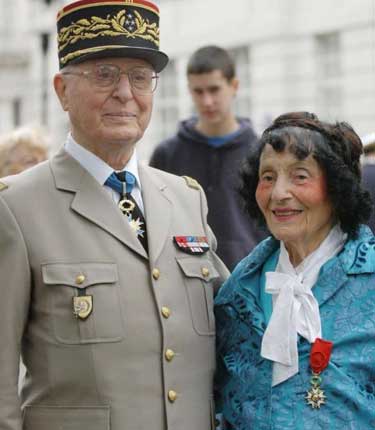Andree Peel: French Resistance fighter who helped Allied airmen evade capture in occupied Europe

Andrée Peel was a French Resistance fighter who embodied everything that General de Gaulle wanted from French men and women. Known as Agent Rose, she survived a Nazi death squad and helped more than 100 British and American airmen evade capture and escape occupied Europe.
Born into a religious and patriotic family in Brittany on 3 February 1905, there was nothing to suggest that Andrée Marthe Virot would become a heroine of the Resistance movement. With the fall of France in June 1940 she was in her mid-thirties and running her own beauty salon in the port of Brest in north-western France.
However, with de Gaulle's famous rousing broadcast on 18 June 1940, when he exclaimed that "France has lost a battle, but she has not lost the war," Virot and a group of friends began to actively defy the occupying forces. She began helping the Resistance by distributing leaflets, and later the organisation's clandestine newspapers. Her enthusiasm was noted and she was promoted to command a Breton sub-section of the Resistance, initially under the codename Agent X and then Agent Rose, with the rank of sous-officier (sergeant).
With Brest's importance as a naval port, its impressive fortifications and its instant access to the Atlantic and close proximity to the Channel, the Germans wasted no time in improving the base and its defences. They built new submarine pens protected by impregnable concrete walls where they housed a large U-boat fleet and improved the work yards for the surface fleet. Virot's brief was to provide military intelligence on the Atlantic Wall (the coastal fortifications) and the Kriegsmarine and Wehrmacht deployments as well as the effects of allied bombing. Her information- gathering prompted Winston Churchill to write a personal letter of congratulation – though it had to be destroyed immediately after reading.
Virot's team, which ran the VAR escape route across the beaches of northern Brittany, used torches to guide allied planes to improvised landing strips for Special Operations Executive drops and pick-ups and smuggled fugitive airmen on to submarines and gunboats along remote parts of the coast. All of this work was extremely hazardous; capture would result in torture and probable execution. During Virot's time in charge, 102 allied airmen passed through her section to freedom.
In 1944, however, the Germans, who realised that an Allied invasion was imminent, increased their efforts to track down resistance cells in the region. Following the capture, torture and confession of a comrade, Virot came under suspicion. She fled to Paris, changing her identity and papers, but three days after D-Day she was captured and taken to Gestapo headquarters on Avenue Foch, where she was subjected to some treatment including simulated drowning – a fore-runner to water boarding – severe beatings to the throat, from which she continued to suffer in later life, and electric-shock torture.
She was then sent to Ravensbrück, the notorious women's concentration camp north of Berlin. Unlike 90,000 other inmates, she survived selection for the gas chamber, thanks to the intervention of a fellow inmate. Finally, with the Red Army advancing, she was transferred south to Buchenwald, near Weimar. It was here, while being lined up to be shot with other internees by the retreating SS, that she cheated death once more thanks to the arrival of a detachment of American troops from the 9th Armoured Infantry Battalion.
Following the war and some convalescence Virot returned to Brest to discover that her father and brother had died, so she moved to Paris to run La Caravelle, a restaurant on the Rive Gauche – where a young English academic, John Peel, walked in one day and stole her heart. Although he was 20 years her junior their relationship developed and they married a few years later, moving to the village of Long Ashton, south-west of Bristol. Years later she still suffered pain, and flashbacks from her torture. In later life, believing she had a gift, Peel became a faith healer and dietician.
Her bravery was honoured with numerous decorations, including the King's Commendation for Bravery, presented to her by King George VI, the US Medal of Freedom, awarded by President Dwight D. Eisenhower and the Croix de Guerre (with palm and another with purple star), as well as appointment to the Légion d'honneur. In 2004, she was upgraded to Chevalier of the Légion, an award presented to her by her brother, the retired four-star General Maurice Virot.
In 1999, Peel reluctantly published her memoirs, Miracles Existent [Miracles do Happen], after it was suggested that in doing so she would tell the story of those who had been less fortunate than her. In 2008, William Ennals, a local film-maker, turned her story into a film, Rose: A Portrait of a Resistance Fighter.
"We were defending freedom," she said of herself and her fellow freedom fighters. "It's an extremely precious thing. It is only when you do not have it that you begin to appreciate how important it is."
Martin Childs
Andrée Marthe Virot, French Resistance fighter and healer; born Brittany 3 February 1905; married John Peel (died 2003); died Long Ashton, near Bristol 5 March 2010.
Join our commenting forum
Join thought-provoking conversations, follow other Independent readers and see their replies
Comments
Bookmark popover
Removed from bookmarks